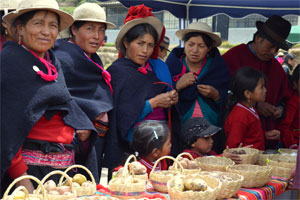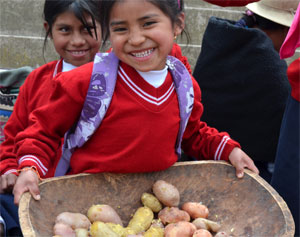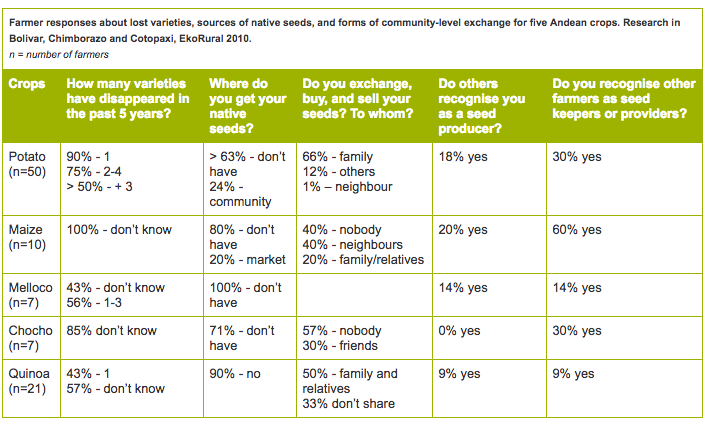In the Ecuadorian provinces of Bolívar, Chimborazo and Cotopaxi, family farmers are building new capacities to conserve and use the biodiversity on their farmland. They are gaining greater access to and control over their biological resources, increasing their resilience and food sovereignty. The key: individual farmers who are passionate about plants and seeds.

Agrobiodiversity enables rural family farmers to cope with the dynamics and shocks that are inherent in farming, especially weather and market fluctuations and pests.
For villages in high altitude and risk-prone environments, such as the Ecuadorian Highland Andes, this is especially important. In the words of farmer Julio Guamo from Naubug village in Chimborazo, “With agrobiodiversity we can produce many different crops. If one does not succeed, others survive, so we don’t lose everything and are able to eat in difficult times.”
Nevertheless, numerous studies in our region showed that on-farm genetic resources have been in sharp decline over the last half-century. Something had to be done.
Farmers as custodians of seeds
Despite owning just 20% of the land and water resources dedicated to agriculture in Ecuador, smallholder family farms provide more than 70% of the country’s staple products. Farmers have historically conserved these traditional seeds and the knowledge about how to use them that form the basis of this food production. Smallholder family farmers are the largest supplier of seeds of both improved and local varieties for the majority of Andean crops. “Improved” seed varieties have never constituted more than 1-2% of planting material in Ecuador.
Since the 1960s, agricultural policies that favoured monocultures and export-led production have neglected smallholder management of genetic resources and weakened the role of the state in improving knowledge and organisation among small farmer systems. Undoubtedly, Ecuador’s current farmer seed system is one of the most conspicuous forms of social self-organisation, encompassing an extensive network of actors, traditions and institutions that has vigorously resisted the influence of external actors and agricultural policies.
Recently, there has been more political and scientific recognition of local biodiversity as a critical element for maintaining resilient and dynamic agricultural systems. For instance, a recent ministerial decree recognises the potential of smallholder family farmers to produce and market potato seeds. The Bill of Agrobiodiversity and Seeds, currently subject to heated debate in the National Assembly, also recognises farmers’ seeds and the need to strengthen the informal system.
Action research on agrobiodiversity
Despite these positive trends, smallholder management of agrobiodiversity is at great risk, as we found in the communities in the central highland provinces of Bolivar, Chimborazo and Cotopaxi between 2007 and 2012.
To assess the state of these communities’ on-farm agrobiodiversity and locally run seed systems, we worked with farming communities to document and share their knowledge about genetic resources and the functions in their lives, as well as on knowledge and practices tied to the management, availability, access and control of seeds.
In addition to conducting approximately 800 surveys with farmers in more than 30 communities, we carried out participatory assessments using a variety of tools for community management of agro-biodiversity. Timelines, transects, focus groups, mapping of farms, and lists of agro-biodiversity were accompanied by a method called Participatory Four Cell Analysis (see also p. 40). This entails in-depth discussion on the destinations of specific crops, their sale, terms of trade, and family consumption, revealing the relevance and importance of particular crops.
We motivated the farmers to start a dialogue about their genetic resources, because it is often felt that only when things are expressed and said, they exist. The main objective of this participatory process was therefore to make visible to the community the role and function of their seeds, and to recognise those individuals with outstanding knowledge and capacity to conserve biodiversity.
Disappearing varieties
Our findings showed that, despite their high nutritional values and historic importance for food security, Andean roots and tubers such as mashua (Tropaeolum tuberosum), oca (Oxalis tuberosa), jícama (Pachyrhizus erosus) and melloco (Ullucus tuberosus) have become infrequent. According to the farmers, several factors have contributed to the decline of these traditional crops. They include the expansion of monoculture planting and market-driven agriculture, which commonly emphasise the cultivation of “European” vegetables. Farmers also mentioned changes in traditional weather patterns, which have increased the risk of crop failure and, as a consequence, the loss of seeds.
The results of our research, some of them summarised in the table, illustrate the systematic loss of community knowledge and control of their biological resources. However, the table also shows that there are farmers who are passionate about managing plants and seeds. These individual leaders hold tremendous value for the transmission of knowledge and the enhancement of socio-technical innovations.
New initiatives
“It was crucial to make the role and function of the seeds visible to the community”
Following this analysis, we strengthened farmers’ awareness of, and control over, their biological resources. For example, we enabled community members to visualise the multiple relationships between farming families and their biological resources and seeds and their livelihood priorities.
We assisted local farmer leaders with conducting experimental learning activities with other farmers, seed circulation, botany, and genetics, by using field days, tours, and farmer-to-farmer exchanges. As a result of this combination of research and action, communities are now more aware and better equipped to start building control over their biological resources.
Recently, communities have started to (re)construct, strengthen and expand their own seed banks. For each seed that farmers receive from the bank, they return two after their harvest. This is a multipurpose support fund: it protects the seed varieties and generates products for continued circulation. A number of pilot banks are now operating with good results. This success is arousing curiosity among other neighbouring communities, who are in the process of setting up their own exchange systems and seed banks. We also identified highly innovative families and worked to build them into a support network of like-minded peers. Through research organisations, they accessed germplasm stored in gene banks, especially to recover lost potato varieties.
Nevertheless, such efforts in the use and conservation of biodiversity will be at risk without new economic models that recognise the value of local food products. If there is no demand for local food, there will be no use for local seeds. In the last four years we have also encouraged a crucial complementary process that connects urban citizens directly with rural producers so that they can access fresh, healthy local food. This stimulates farmers to continue growing a variety of crops using agro-ecological practices, reconnecting the cultural and political aspects of food. Already, we see that this is having a very positive impact on health, the environment and the local economy.
Slowly but steadily building change

We started small with short, inspiring experiences, which have enabled community members and organisations to become active stakeholders with vested interests in the process. These processes take time to implement, but once they become embedded in the community structure they are ultimately much more sustainable.
The result has been a slow but steady counter-movement against the continued loss of biodiversity in these communities. Several actors, including non-governmental organisations, universities, research institutes and local governments have begun to promote discussion on the value and relevance of conserving and utilising native biodiversity.
Urban organisations are actively involved in the discussion on the new laws of food sovereignty, agrobiodiversity and seeds, among others. Both the community members and ourselves feel that this experience needs to be continued and expanded to new crops and territories.
For us, the key factor of success has been to work with (rather than against) local experiences. Everywhere, even under the most difficult conditions of hardship and social marginalisation, there are always families that are capable of defending and advancing their own on-farm biodiversity. We find great hope and inspiration in these families. The challenge is in finding ways to strengthen their knowledge and to build linkages with other like-minded people to stand firm against the ongoing threats and mass-marketing of industrial agriculture and industrial foods.
Ross Mary Borja, Pedro Oyarzún, Sonia Zambrano, Francisco Lema and Efraín Pallo
Ross Mary Borja, Pedro Oyarzún, Sonia Zambrano, Francisco Lema and Efraín Pallo work with the EkoRural Foundation in Quito, Ecuador.
E-mail: rborja@ekorural.org.
The authors wish to thank the participating campesino organisations from the Central Highlands, Steve Sherwood, Keely McCaskie, the McKnight Foundation, the Dutch Embassy, the Tidlund Foundation, the Swift Foundation, and the Food and Agriculture Organization of the United Nations for their contributions.


